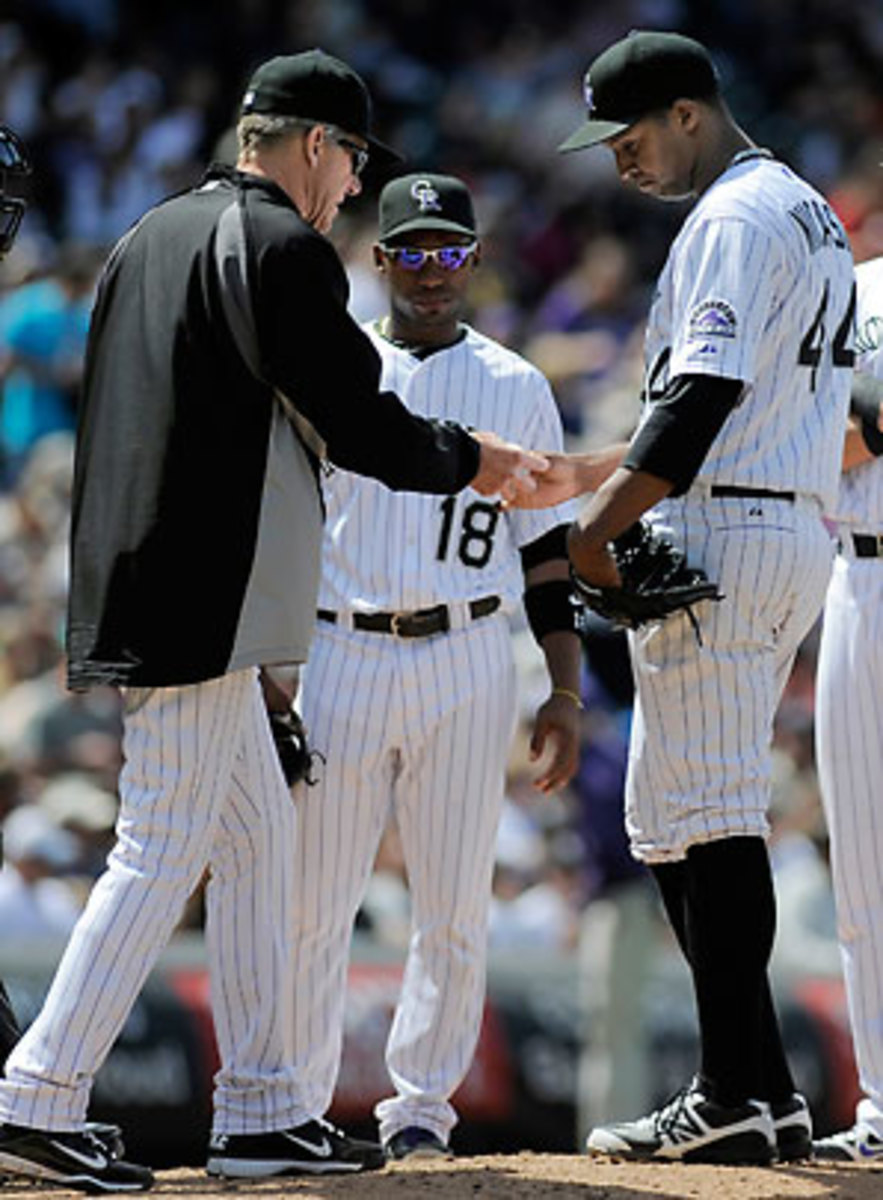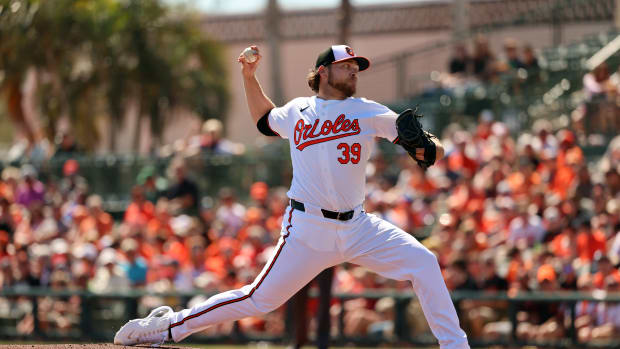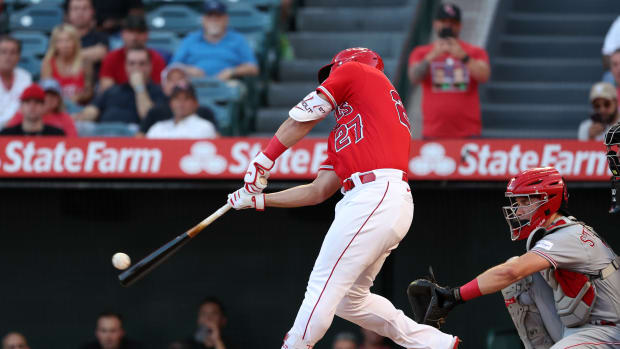Rockies' experiment with four-man rotation won't work
For Colorado's plan to work, manager Jim Tracy will need his pitchers to be far more effective than they have been so far. (AP)
For decades, statheads have called for teams to turn back the clock by reverting to four-man pitching rotations from the five-man ones that first took hold at the major league level in the early 1970s and advanced throughout the game over the ensuing decade. Since then, the occasional team has briefly experimented with four starters, and Tony La Russa even went to three for about a week with Oakland in 1993. Those changes were short-lived, however. So it was difficult to take seriously Tuesday's announcement from Rockies manager Jim Tracy that his team was not only switching to a four-man rotation, but that it would do so while keeping its starters on a 75-pitch limit.
The problem isn't that the idea of a four-man rotation has no merit. In the abstract, taking starts away from a team's fifth-best starting pitcher and redistributing them among four better ones should save dozens of runs per year. Likewise, limiting the number of pitches thrown in a given outing should not only be less taxing from a fatigue standpoint — and potentially an injury one — but should hold down the number of runs allowed, since batter performance tends to improve the more often a given hitter faces a starter in a single game, and drops the first time facing a reliever.
No, the problem is that the Rockies don't appear to have the personnel to pull this off, and the experiment appears set for failure. If and when it does fall apart, it could take years before a better-equipped team dares to try such an unconventional move again.
The Rockies' rotation is downright awful, even beyond the fact that they're toiling in Coors Field, the game's least pitcher-friendly environment. Their 6.31 ERA is dead last in baseball, and more than two runs worse than the average starter's ERA of 4.15. Their 5.19 innings per start is second-to-last; the major league average is 5.96. Rockies starters are delivering quality starts (by definition six or more innings, three or fewer earned runs) just 26 percent of the time, not only the game's worst rate but also half of the major league average.
Of the 10 pitchers who have started at least one game for Colorado this year, only Drew Pomeranz has an ERA below 5.28, and he was sent down to Triple-A in mid-May to work on his control after five turns and a 4.70 ERA accompanied by 5.9 walks per nine. The five pitchers who took their most recent turns before this decision — Josh Outman, Alex White, Jeff Francis, Christian Friedrich and Jeremy Guthrie — have ERAs of 8.41, 5.56, 12.46, 5.60, and 7.02, respectively, though Outman has just four starts under his belt and Francis two. Injuries have caused considerable turnover; a shoulder problem bumped Jhoulys Chacin from the rotation after just five turns and a 7.30 ERA, while a knee problem claimed Juan Nicasio two weeks ago after a comparatively respectable 5.28 ERA in 11 turns.
Remember, too, that 49-year-old Jamie Moyer got the axe late last month after delivering a 5.70 ERA in 10 turns because the Rockies wanted to focus on their younger pitchers, and indeed, several of the aforementioned are still wet behind the ears. Pomeranz and White are both 23-year-old rookies, Chacin and Friedrich are both 24 (the latter is a rookie) and Nicasio is 25. All are considered to have bright futures; the first four of those pitchers made two appearances on Baseball America's Top 100 Prospects list in recent years, while the last of them held his own in the Rockies' rotation last year after just nine starts above High-A, at least until he suffered a scary neck injury from which he has made a remarkable comeback. With Moyer gone, only Guthrie (33) and Francis (31) are in their 30s.
The problem isn't that these pitchers collectively lack talent, it's that their talent is a poor fit for their current environment. Back in 2009, the Rockies won the NL Wild Card in large part because their rotation delivered a 4.10 ERA, seventh-best in the majors. They succeeded despite pitching half their games in Coors Field because they limited home runs by keeping the ball on the ground; the rotation collectively allowed 0.8 homers per nine, fourth-best in the majors. Their top five starters — Ubaldo Jimenez, Jason Marquis, Jorge De La Rosa, Jason Hammel and Aaron Cook — combined for 155 of Colorado's 162 starts and had groundball rates of 55.4, 56.4, 46.4, 48.4, and 57.9 percent, respectively. Only Cook (the most extreme grounballer, ironically) had a homer rate higher than 1.0 per nine.
By comparison, the Rockies' top five starters this year by innings pitched — Guthrie, Nicasio, Moyer, White and Friedrich — have groundball rates of 43.4, 41.2, 46.2, 58.1 and 41.3 percent, respectively (Chacin and Pomeranz are in the low 40s, Outman and Francis above 50 percent, albeit in much smaller sample sizes). Of that quintet, Nicasio's 1.1 homers per nine is the low mark, with Moyer at 1.8 and Guthrie at an absurd 2.3; the unit as a whole is allowing 1.6 per nine, double the 2009 rate.
Guthrie, who was acquired from the Orioles over the winter in a deal for the surging Hammel, and Guillermo Moscoso (a 28-year-old who had the majors' lowest groundball rate last year and who has a 6.75 ERA in 22 2/3 innings over seven appearances, including two starts this year) are the designated long relievers in this new scheme. Guthrie's new role as a reliever comes despite the fact the team is willing to trade him -- something of a backwards plan.
Even more backwards is the idea that holding the remaining four pitchers (White, Francis, Friedrich and Outman) to 75 pitches is going to save the bullpen work. Because these pitchers aren't very efficient -- all are walking more than the major league average of 3.1 per nine, and giving up hits and runs by the bushel -- they're rarely going to make it very far into games; if they're barely averaging five innings per turn now, it's a safe bet they won't reach that mark very often under the new plan. Similarly, thinking that ineffective flyballers Guthrie and Moscoso are going to bridge the gap effectively also appears to be off base.
The numbers do provide a couple glimmers of hope for the Rockies. As shown in the following table, their starters' performance against hitters based upon the number of times facing them per game has lagged well behind the major league average, while their relievers have lagged behind to a much smaller degree, with those pitchers' first encounter with hitters far superior to that of their starters' third or fourth encounters:
Group | PA | AVG | OBP | SLG | OPS | difAvg | difOBP | difSLG | difOPS |
MLB | SP1 | .247 | .310 | .393 | .703 | ||||
MLB | SP2 | .260 | .321 | .417 | .738 | ||||
MLB | SP3+ | .271 | .332 | .439 | .771 | ||||
MLB | RP1 | .241 | .316 | .375 | .691 | ||||
COL | SP1 | .280 | .350 | .480 | .830 | .033 | .040 | .087 | .127 |
COL | SP2 | .351 | .411 | .585 | .996 | .091 | .090 | .168 | .258 |
COL | SP3+ | .330 | .397 | .536 | .933 | .059 | .065 | .097 | .162 |
COL | RP1 | .264 | .335 | .411 | .746 | .023 | .019 | .036 | .055 |
SP1 is the first time a starting pitcher faces a batter in the game, SP2 is the second time and SP3+ is for all subsequent encounters, while RP1 is the first time a relief pitcher faces a hitter. Note the lower right-hand corners, which show that in terms of OPS relative to the major league average, there is more than a 100-point difference between the third (or fourth) time a Rockies starter faces a hitter and the first time a reliever does so. All else being equal, that should improve their run prevention. Meanwhile, assuming the timing works out, their offense would see an additional gain from using an extra pinch-hitter for the pitcher the second time through the batting order.
The problem is that all else may not be equal. One can't know offhand whether the lower pitch counts will offset the shorter rest, since these pitchers will be generally working on three days' rest instead of four, some of them probably for the first time in their professional careers, forcing them into unfamiliar routines in the middle of the season. The data for starter usage on short rest is almost worthless in this case, since pitchers who do go short tend to be elite ones; think CC Sabathia taking the ball every fourth day down the stretch for the 2008 Brewers. No, this is a shot in the dark on that front.




































